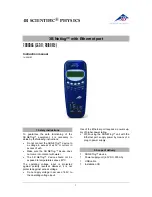
3... I
NTERFACE
M
ODULES
U
SING
T
HE
OMP-MODL
3-28
To minimize noise pickup on sensor wiring between the OMP-MODL and the
end sensor or signal source, 18 to 22 AWG shielded, twisted pair wire is
recommended. At the low current levels input to the MLIM-1, voltage drop
in signal wiring is not a concern, however for extremely long runs, a voltage
drop analysis should be performed for the entire loop and if necessary larger
gauge wire should be used.
FYI:
Typically, with current signals (in contrast to low
level voltage signals), noise pickup will be less due to the
low impedances involved in the circuit. However, in real-
world applications, one should attempt to minimize noise
on signal wires whenever possible... remember, Mother
Nature loves to throw surprise parties.
Shielded wire minimizes the amount of noise picked up
by the internal conductors carrying the signals by
providing an `electrical shell’ or Faraday cage around the
internal conductors.
Twisted pair wiring exposes both conductors equally to
the ambient electrical noise. This common-mode type
noise is easier to reject by the Interface Modules input
signal conditioning circuitry than un-balanced (or
differential) noise.
Shielding and/or twisted pair wire is especially recommended in electrically
noisy environments for optimum signal protection. If shielded wire is used, a
ground wire should be run from the MLAD-1 module Chassis Ground
(terminal strip connection #16) to an earth ground connection to conduct
away noise picked up by the wiring shield (Figure 2-8). Only one ground
wire is required as all of the Shield terminal strip connections are
Terminal Strip
ml057
4-20mA
Panel Meter
+ XTMR -
4-20mA
Controller
Power
Supply
+ XTMR -
+
-
+
-
+
-
+
-
+ -
A
B
GND
1
2
3
4
5
6
7
Figure 3... -16: Terminal strip connections for multiple 4-20mA inputs
Summary of Contents for OMP-MODL
Page 1: ......
Page 9: ...1 INTRODUCTION USING THE MODULOGGER 1 7 13 ...
Page 23: ...2 OMP MODL System Base Using the OMP MODL 2 14 NOTES ...
Page 24: ...2 ModuLogger System Base Using the ModuLogger 2 1 ...
Page 30: ...3 INTERFACE MODULES USING THE OMP MODL 3 6 NOTES ...
Page 70: ...3 INTERFACE MODULES USING THE OMP MODL 3 46 NOTES ...
Page 76: ...3 INTERFACE MODULES USING THE OMP MODL 3 52 NOTES ...
Page 82: ...3 INTERFACE MODULES USING THE OMP MODL 3 58 NOTES ...
Page 83: ...3 INTERFACE MODULES USING THE MODULOGGER 3 1 ...
Page 105: ...5 HYPERCOMM COMMUNICATIONS USING THE OMP MODL 5 18 NOTES ...
Page 106: ...5 HYPERCOMM COMMUNICATIONS USING THE MODULOGGER 5 1 ...
Page 117: ...6 PCMCIA CARD CONFIGURATION AND USE USING THE MODULOGGER 6 1 ...
Page 134: ...7 HYPERNET ICON BASED PROGRAMMING USING THE OMP MODL 7 17 NOTES ...
Page 141: ...8 P P C D U OMP MODL ...
Page 149: ...9 HYPERPLOT GRAPHIC DATA DISPLAY USING THE OMP MODL 9 8 ...
Page 161: ...10 HYPERTRACK REAL TIME DATA DISPLAY USING THE OMP MODL 10 12 NOTES ...
Page 162: ...10 HYPERTRACK REAL TIME DATA DISPLAY USING THE OMP MODL 10 1 ...
Page 163: ...11 APPENDICES USING THE OMP MODL 11 1 11 APPENDICES ...
Page 164: ...11 APPENDICES USING THE OMP MODL 11 2 NOTES ...
Page 270: ...11 APPENDIX A MASTER ICON FILE REFERENCE USING THE OMP MODL 11 108 ...
Page 276: ...11 APPENDIX C HYPERWARE FILE LISTING USING THE OMP MODL 11 114 NOTES ...
Page 278: ...11 APPENDIX C HYPERWARE FILE LISTING USING THE OMP MODL 11 116 NOTES ...
Page 279: ......
Page 282: ...11 APPENDIX E CHANGING THE OMP MODL EPROM USING THE OMP MODL 11 120 NOTES ...
Page 288: ...11 APPENDIX G HYPERNET THEORY OF OPERATION USING THE OMP MODL 11 126 NOTES ...
Page 290: ...11 APPENDIX I RS 232 CABLE PORT AND ADAPTER USING THE OMP MODL 11 128 NOTES ...
Page 297: ...11 APPENDIX K MODEM CONFIGURATION USING THE OMP MODL 11 135 ...
















































